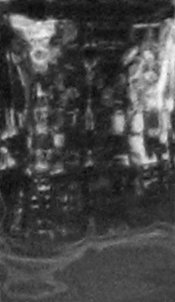Bill Burk
Subscriber
- Joined
- Feb 9, 2010
- Messages
- 9,383
- Format
- 4x5 Format
Watching "Bunny" Hanson pull a Disc camera from his shirt pocket... And recalling my own fascination with the Pocket Instamatic when it was first released (I craved the Model 60 but bought the Model 20 and studied the manual cover to cover so I knew to change shutter speed with a matchstick when shooting in the rain)...
Got me to thinking about the lower limits of acceptable image quality. And the upper limits. And what beginners should shoot. And what standards you might wish you had upheld from the get-go.
I wasn't concerned with image quality when I first started out. I was satisfied with the 110 Pocket Instamatic for a few years. I shot smaller cameras (mom had a "Hit" camera) and larger (she also had a Ricohflex). I didn't even respect the negatives. In the darkroom I'd cut the 6x6 negative with scissors to fit the American Science Club kit of the month enlarger.
I got hooked on 35mm when dad got the Spotmatic II and for dozens of years I didn't see a need to shoot 120 or 4x5 (though I dabbled in these). 35mm did all I wanted and it was professionally accepted.
Something flipped a few years after I got married. My wife showed me her parents wedding album and asked me to make copies for the family. Sure I knew how to do this... Just as when I was 14, I got the 35mm, macro, copystand, clip bulbs and Panatomic-X and made terrific copies of the prints. I made the prints on Galerie and the family all have them now... But I could immediately see a generation loss of quality, and it got my goat.
Approaching my 50th birthday (few years ago now...) asked if I could have any camera in the world... I knew digital was overtaking 35mm, but wasn't there yet (my opinion), so the last camera I'd ever need, had to be 4x5. (Left out the fact that my career gave me access to tools to work with 300mb files, but I was only able to make 30mb fuzzy files from my 35mm slides - the only way to get better digital files was scanning backs... and a local photographer already was making his reputation on that path).
So to be different and better, I picked 4x5. I decided all the shots I take from now on, that might be done as well on a Pocket Instamatic, I'm going to do on 4x5 whether it needs it or not. If I nail a shot, then I really have something. If I get just a snapshot, that's fine.
I'd found out, that the converse really isn't a good place to be... Nailing a shot with a Minox... Not really going to be up on the wall... Maybe I'll post an example.
Got me to thinking about the lower limits of acceptable image quality. And the upper limits. And what beginners should shoot. And what standards you might wish you had upheld from the get-go.
I wasn't concerned with image quality when I first started out. I was satisfied with the 110 Pocket Instamatic for a few years. I shot smaller cameras (mom had a "Hit" camera) and larger (she also had a Ricohflex). I didn't even respect the negatives. In the darkroom I'd cut the 6x6 negative with scissors to fit the American Science Club kit of the month enlarger.
I got hooked on 35mm when dad got the Spotmatic II and for dozens of years I didn't see a need to shoot 120 or 4x5 (though I dabbled in these). 35mm did all I wanted and it was professionally accepted.
Something flipped a few years after I got married. My wife showed me her parents wedding album and asked me to make copies for the family. Sure I knew how to do this... Just as when I was 14, I got the 35mm, macro, copystand, clip bulbs and Panatomic-X and made terrific copies of the prints. I made the prints on Galerie and the family all have them now... But I could immediately see a generation loss of quality, and it got my goat.
Approaching my 50th birthday (few years ago now...) asked if I could have any camera in the world... I knew digital was overtaking 35mm, but wasn't there yet (my opinion), so the last camera I'd ever need, had to be 4x5. (Left out the fact that my career gave me access to tools to work with 300mb files, but I was only able to make 30mb fuzzy files from my 35mm slides - the only way to get better digital files was scanning backs... and a local photographer already was making his reputation on that path).
So to be different and better, I picked 4x5. I decided all the shots I take from now on, that might be done as well on a Pocket Instamatic, I'm going to do on 4x5 whether it needs it or not. If I nail a shot, then I really have something. If I get just a snapshot, that's fine.
I'd found out, that the converse really isn't a good place to be... Nailing a shot with a Minox... Not really going to be up on the wall... Maybe I'll post an example.







 :
:



